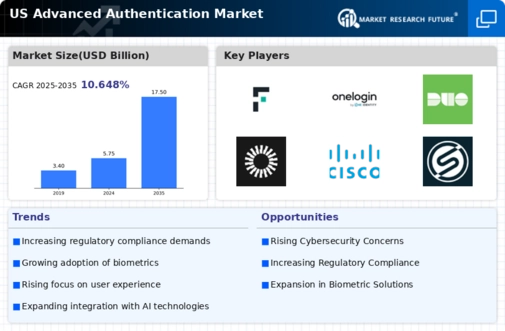The advanced authentication market is characterized by a dynamic competitive landscape, driven by the increasing demand for robust security solutions amid rising cyber threats. Key players such as Microsoft (US), IBM (US), and Okta (US) are strategically positioned to leverage their technological prowess and extensive resources. Microsoft (US) focuses on integrating advanced authentication into its cloud services, enhancing user experience while ensuring security. IBM (US) emphasizes innovation through its AI-driven security solutions, aiming to provide adaptive authentication mechanisms. Okta (US), on the other hand, is dedicated to simplifying identity management, which is crucial for organizations transitioning to cloud-based infrastructures. Collectively, these strategies foster a competitive environment that prioritizes innovation and user-centric solutions, shaping the market's trajectory.
In terms of business tactics, companies are increasingly localizing their operations to better serve regional markets, optimizing supply chains to enhance efficiency. The advanced authentication market appears moderately fragmented, with a mix of established players and emerging startups. This structure allows for diverse offerings, yet the influence of key players remains substantial, as they set benchmarks for innovation and service quality.
In October 2025, Microsoft (US) announced the launch of its new Azure Active Directory features, which incorporate biometric authentication methods. This strategic move is significant as it aligns with the growing trend towards passwordless solutions, enhancing security while improving user convenience. By integrating these features, Microsoft (US) not only strengthens its market position but also addresses the evolving needs of enterprises seeking to mitigate security risks.
In September 2025, IBM (US) unveiled its latest AI-driven security platform, which includes advanced authentication capabilities tailored for financial institutions. This initiative is crucial, as it reflects IBM's commitment to addressing sector-specific security challenges. The platform's ability to adapt authentication processes based on real-time risk assessments positions IBM (US) as a leader in providing customized security solutions, potentially increasing its market share in the financial sector.
In August 2025, Okta (US) expanded its partnership with leading cloud service providers to enhance its identity management solutions. This collaboration is strategically important as it allows Okta (US) to integrate its authentication services more seamlessly into various cloud environments. By doing so, Okta (US) not only broadens its customer base but also reinforces its position as a key player in the identity management space, catering to the growing demand for secure cloud solutions.
As of November 2025, the advanced authentication market is witnessing trends such as digitalization, AI integration, and a heightened focus on sustainability. Strategic alliances among key players are shaping the competitive landscape, fostering innovation and collaboration. Looking ahead, it is likely that competitive differentiation will increasingly hinge on technological advancements and supply chain reliability, rather than solely on price. This shift underscores the importance of innovation and adaptability in navigating the complexities of the market.
























Leave a Comment